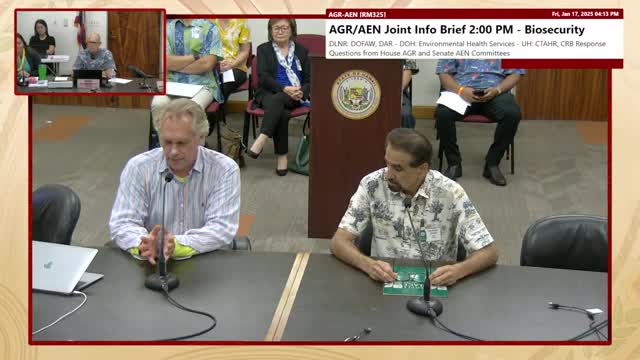Hawaii explores viral biocontrol methods to combat invasive beetles and coral disease threats
January 18, 2025 | House Committee on Agriculture & Food Systems, House of Representatives, Legislative , Hawaii
This article was created by AI summarizing key points discussed. AI makes mistakes, so for full details and context, please refer to the video of the full meeting. Please report any errors so we can fix them. Report an error »

In a recent meeting held by the House Committee on Agriculture & Food Systems in Hawaii, discussions centered on innovative approaches to pest control and the potential threats to local ecosystems. The meeting, which took place on January 17, 2025, highlighted the importance of exploring pathogen-based biocontrol methods, particularly in light of ongoing challenges with invasive species.
One of the key topics was the exploration of viral biocontrol as a method to manage pest populations in Hawaii. A virologist shared insights on successful efforts in New Zealand, where similar viruses have been used to combat beetle populations. This approach could offer a new avenue for controlling pests that threaten Hawaii's unique environment. The virologist emphasized the need for thorough research and regulatory approval before any potential release of pathogens, noting that the timeline for such initiatives could range from three to eight years, depending on regulatory processes.
Additionally, the meeting addressed concerns regarding the stony coral tissue loss disease, which poses a significant risk to Hawaiian corals. A representative from the Department of Land and Natural Resources (DLNR) was questioned about the potential pathways for this disease to reach Hawaii and the department's plans to mitigate its impact. The discussions underscored the urgency of protecting Hawaii's marine ecosystems from emerging threats.
Overall, the meeting served as a platform for sharing critical information on pest management and environmental protection strategies. As Hawaii navigates these complex issues, the integration of scientific research and regulatory oversight will be essential in safeguarding its unique biodiversity. The committee's ongoing efforts reflect a commitment to addressing both current and future challenges facing the state's agriculture and natural resources.
One of the key topics was the exploration of viral biocontrol as a method to manage pest populations in Hawaii. A virologist shared insights on successful efforts in New Zealand, where similar viruses have been used to combat beetle populations. This approach could offer a new avenue for controlling pests that threaten Hawaii's unique environment. The virologist emphasized the need for thorough research and regulatory approval before any potential release of pathogens, noting that the timeline for such initiatives could range from three to eight years, depending on regulatory processes.
Additionally, the meeting addressed concerns regarding the stony coral tissue loss disease, which poses a significant risk to Hawaiian corals. A representative from the Department of Land and Natural Resources (DLNR) was questioned about the potential pathways for this disease to reach Hawaii and the department's plans to mitigate its impact. The discussions underscored the urgency of protecting Hawaii's marine ecosystems from emerging threats.
Overall, the meeting served as a platform for sharing critical information on pest management and environmental protection strategies. As Hawaii navigates these complex issues, the integration of scientific research and regulatory oversight will be essential in safeguarding its unique biodiversity. The committee's ongoing efforts reflect a commitment to addressing both current and future challenges facing the state's agriculture and natural resources.
View full meeting
This article is based on a recent meeting—watch the full video and explore the complete transcript for deeper insights into the discussion.
View full meeting
